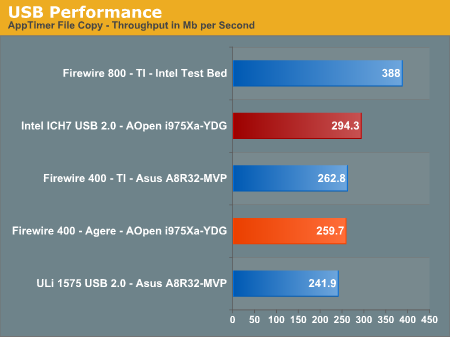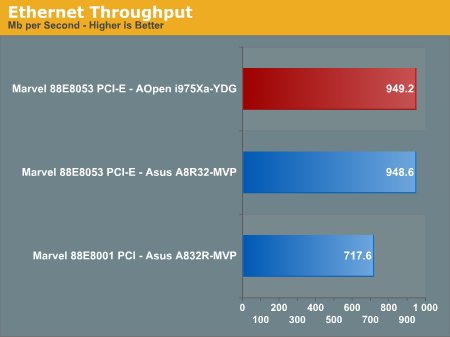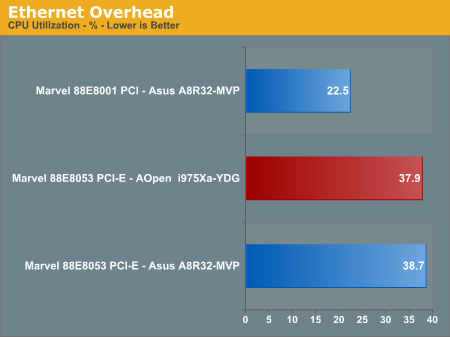Intel Core Duo: AOpen i975Xa-YDG to the Rescue
by Gary Key on May 4, 2006 8:00 AM EST- Posted in
- Motherboards
Firewire and USB Performance
After looking at many options for Firewire and USB testing, we finally determined that an external USB 2.0, Firewire 400, and Firewire 800 hard disk would be a sensible way to look at USB and Firewire throughput. We utilize a RAM disk as our "server", since memory removes almost all overhead from the serving end. We turn off disk caching on the USB and Firewire side by setting up the drives for "quick disconnect" so our results are consistent.We use 2GB of fast 3-3-3-8 system memory set up as a 450MB RAM disk and 1550MB of system memory. Our standard file is the SPECviewPerf install file, which measures 432,533,504 bytes (412.4961MB). After copying this file to our RAM disk, we measured the time for writing from the RAM disk to our external USB 2.0, Firewire 400, or Firewire 800 drive utilizing our internal Windows based timing program. The copy times in seconds were then converted into Megabits per second (Mb) to provide a convenient means of comparing throughput. Higher Rates therefore mean better performance in this particular test.

Possibly the most interesting finding in our Firewire and USB throughput tests is the outstanding performance of an external hard drive connected to Firewire 800. Our benchmarks show Firewire 800 is up to 48% faster than a drive connected to the more common Firewire 400, and about 32% faster than the fastest USB 2.0 solution.
The AOpen board offers the Agere based IEEE 1394 Firewire option that provides very competitive performance with the more common TI chipset solutions. The Intel USB 2.0 performance offers 22% better performance than the ULi based controller in throughput.
Ethernet Performance
The current motherboard test suite includes LAN performance measurements. All of these boards utilize PCI or PCI Express based controllers with the only difference being the supplier of the core logic.The Windows 2000 Driver Development Kit (DDK) includes a useful LAN testing utility called NTttcp. We used the NTttcp tool to test Ethernet throughput and the CPU utilization of the various Ethernet Controllers used on the Intel motherboards.
We set up one machine as the server; in this test, an Intel system with an Intel CSA Gigabit LAN connection. Intel CSA has a reputation for providing fast throughput and is a logical choice for our Gigabit LAN server.
On the server side, we used the following Command Line as suggested by the VIA whitepaper on LAN testing:
Ntttcpr -m 4,0,‹server IP› -a 4 -l 256000 -n 30000
Ntttcps -m 4,0,‹client IP› -a 4 -l 256000 -n 30000


AOpen's choice of the Marvell 88E8053 10/100/1000Mb/s Ethernet controller is an excellent addition to this board. The performance is basically equal to that of the same Marvell 88E8053 controller utilized on the Asus board. The lower CPU utilization rate on the Marvel 88E8001 PCI controller is directly attributable to the lower throughput numbers generated in our tests.










81 Comments
View All Comments
Gary Key - Friday, May 5, 2006 - link
Sorry, being a selfish s.o.b. with this drive, actually I am testing two of them for an upcoming article. :)
sabrewulf - Thursday, May 4, 2006 - link
I haven't been following the development of Conroe too closely, but isn't this chip essentially performing like Conroe will? Or am I missing something?Some of the tests were impressive, but the gaming tests were certainly not "20-40%" improvement over AMD like everyone is wishing.
MrKaz - Thursday, May 4, 2006 - link
And "will" never be.Don’t forget Intel was using:
- Some special ATI driver.
- Crossfire setup (maybe modified),
20%~40% that you will never get, unless you have such kind of configuration.
On non SLI/Crossfire configuration will never be higher than 5%, 10% improvement...
And thanks that a lot to the 4MB cache, and minor processor (P3 redesign) changes.
Don’t forget that the Intel dual core with 4MB shared cache can act as one BIG single core processor with 4MB cache and the second core with 0MB of cache for the extra “stupid” calc...
IntelUser2000 - Thursday, May 4, 2006 - link
LOL. I always doubt that people can be such a dumb fanboy even I see them over and over again in time.
How do you explain Xtremsystems benchmark, and all the architectural advantages?? Did Netburst's poor showing really blind you??
MrKaz - Friday, May 5, 2006 - link
Fun boy me?It's you who calls him self by the stupid nick name Inteluser2000.
Some time there are complete morons here and you are one of them.
ME the "fan boy" has to "defend" Intel, a thing that you with your little brain can’t do.
Read my reply to your fan boy friends, there you will find why conroe will be good, and it's not because it's Intel.... dumb moron....
redbone75 - Thursday, May 4, 2006 - link
I don't think it was a "special" driver per se, if I recall the driver had some changes made in order to recognize Conroe.
I just love how a lot of people refer to Conroe as a P3 redesign as if it's something so bad. No, it's not a P3 redesign, there are elements of what made the P3 so successful incorporated into the chip, but that's not what makes the chip so awesome. Also, so what if it is ultimately just a "P3 redesign" as you put it? You use what works, and obviously this works. Hey, the K7 core was pretty good, and K8 is so well designed that AMD can ride it for a few more years.
MrKaz - Friday, May 5, 2006 - link
"in order to recognize Conroe"Why they need to recognize Conroe?
-Would work?
-Did work but with inferior performance?
-Special optimizations?
-New instruction set (SSE4) support for improved performance?
Questar - Thursday, May 4, 2006 - link
Wow, some fanboys are still in denial.This is an interim MOBILE chip that just put the smack down on an Opteron. What's going to happen when the real thing comes out?
MrKaz - Friday, May 5, 2006 - link
When the real thing come out? That’s easy:Core duo plus:
- 2MB cache (+5%~10%)
- 2X FSB (+4%~8%)
- 800Mhz DDR2 (3%~6%)
- x64 support (0%)
- Higher clock speed 2.1Ghz to 3.3Ghz (anyone can say 50% performance increase?)
I’m not a fan boy, it’s you Intel stupid morons that can even read and make some thought why should Conroe be faster than AMD Athlon 64….
Go back and reread the article about:
Intel Core versus AMD's K8 architecture
Don’t expect conroe be very different from core duo... I’m not saying that’s bad…
Questar - Friday, May 5, 2006 - link
You forgot a couple of things:Addidtional ALU Unit
Twice the SSE performace
Better code reordering
Larger reservation station
New micro-ops